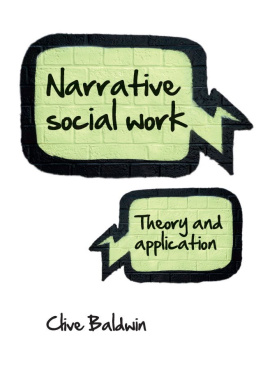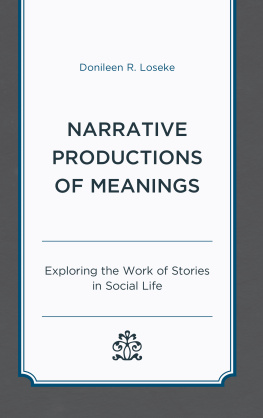First published in Great Britain in 2013 by
The Policy Press
University of Bristol
Fourth Floor
Beacon House
Queens Road
Bristol BS8 1QU
UK
t: +44 (0)117 331 4054
f: +44 (0)117 331 4093
www.policypress.co.uk
North America office:
The Policy Press
c/o The University of Chicago Press
1427 East 60th Street
Chicago, IL 60637, USA
t: +1 773 702 7700
f: +1 773-702-9756
www.press.uchicago.edu
The Policy Press 2013
British Library Cataloguing in Publication Data
A catalogue record for this book is available from the British Library.
Library of Congress Cataloging-in-Publication Data
A catalog record for this book has been requested.
ISBN 978 1 84742 825 7 paperback
ISBN 978 1 84742 826 4 hardcover
The right of Clive Baldwin to be identified as author of this work has been asserted by him in accordance with the Copyright, Designs and Patents Act 1988.
All rights reserved: no part of this publication may be reproduced, stored in a retrieval system, or transmitted in any form or by any means, electronic, mechanical, photocopying, recording, or otherwise without the prior permission of The Policy Press.
The statements and opinions contained within this publication are solely those of the author and not of the University of Bristol or The Policy Press. The University of Bristol and The Policy Press disclaim responsibility for any injury to persons or property resulting from any material published in this publication.
The Policy Press works to counter discrimination on grounds of gender, race, disability, age and sexuality.
Cover design by Qube Design Associates, Bristol
Front cover: image kindly supplied by istock.com
Printed and bound in Great Britain by TJ International, Padstow
The Policy Press uses environmentally responsible print partners
Readers Guide
This book has been optimised for PDA.
Tables may have been presented to accommodate this devices limitations.
Image presentation is limited by this devices limitations.
To Patty and Sarah
Contents
Acknowledgements
As with all my academic writing, this book is the result of many a discussion with colleagues and friends who deserve more credit than a simple note in the acknowledgements. Their consistent and persistent patience, critical friendship and good humour have helped enormously, especially at difficult times.
I would like also to thank Karen Bowler, commissioning editor at The Policy Press, for not giving up on me after I missed deadline after deadline.
To my research assistants here at St Thomas, Carolyn Hill and Brittany Stairs, I owe much in terms of their assistance with ) was undertaken initially by Mary-Dan Johnston and revised and extended by myself, and so the chapter appears as co-authored. Thanks also to Lauren Eagle for her final proofreading.
My especial thanks to Brandi Estey-Burtt who has far exceeded what I could have hoped for in a research assistant. Asked to produce an initial draft piece on mental health and narrative she produced an excellent text that required so little revision that it is only fair that it appear under her name alone (). My contribution to this chapter was more in guidance than writing. Similarly, her work on the chapter on narrative theory was of such a quality that it deserves co-authorship. It must also be noted that there is evidence of her hand throughout the book, with her careful editing, proofing and checking of references. I cannot thank her enough.
And, of course, to Patty, for bearing with me through the ups and downs of writing this, accepting the missed weekends and keeping our beloved border collie, Jagger, happily occupied while I wrote.
About the authors
Clive Baldwin is Canada Research Chair in narrative studies and director of the Centre for Interdisciplinary Research on Narrative at St Thomas University in Fredericton, New Brunswick, Canada. He has extensive experience in narrative research in the social sciences, particularly on allegations of child abuse and ethical issues in dementia. He has published on narrative as it pertains to child abuse, legal cases, ethics, personhood and citizenship, dementia and social policy. As Canada Research Chair he is engaged in research on institutional narratives, narrative literacy in professional education and narrative ethics.
Brandi Estey-Burtt has a Bachelor of Arts in English from St Thomas University and a Master of Arts in English from McMaster University, Hamilton, Ontario. She co-authored a chapter on narrative care for the forthcoming Oxford textbook of old age psychiatry and has been involved with the publication of a number of community projects.
Mary-Dan Johnston completed her Bachelor of Arts at St Thomas University and is pursuing a Masters degree at the University of Oxford, UK, as a Rhodes Scholar.
Part I
Narrative
Introduction
It is common now to talk of the narrative turn the use of narrative concepts and methods in a wide array of disciplines. Seemingly we find narrative under every stone and in every nook and cranny narrative ethics, philosophy, theology, biology, history, anthropology, gender studies, sociology, psychology, psychiatry, medicine, rhetoric, management and leadership, and even the hard sciences of mathematics, chemistry and physics. One cannot but find narrative wherever one wanders.
In social work, however a profession that is, I think, so obviously narrative in nature the literature on narrative is surprisingly limited. In their review of the narrative and social work literature, Riessman and Quinney (2005) found that for the largest part the literature concerned itself with narrative as a method, followed by narrative and social work education and then by autobiographical accounts. With regard to the use of narrative concepts and methods in social work research, Riessman and Quinney were disappointed by their limited use and by the variable quality of the narrative research they found. It is worth noting, however, that one exemplar that Riessman and Quinney cite explores storytelling at team meetings and addresses how cases are made through storytelling (White, 2002). This process of constructing cases through narrative has also been explored by Hall (1997), Urek (2005) and myself (Baldwin, 2005). Both Hall and Urek use narrative as a means of understanding social work per se, rather than simply an adjunct to its primary practices. This is in contrast to other authors who use narrative in a more limited fashion. Wells (2010) and Poindexter (2002), for example, use narrative simply to analyse the accounts of service users as a means of understanding those service users; Roscoe (2009) and Roscoe et al (2011) articulate narrative as a therapeutic intervention; and Gorman (1993), embraces both of these approaches; all fail to understand the fundamental narrative nature of social work. While narrative can be useful in analysis and as therapy, I believe that social work in its working up of cases, assessments, care plans, reviews and their presentation to supervisors, panels and courts is, essentially, a narrative activity. Coming closer to this view are authors such as Pithouse (1987) and Pithouse and Atkinson (1988), who analyse conversations in a social work office in terms of narrative construction, and Hall et al (2006), who explore the day-to-day language practices employed by social workers. The strengths of this form of discourse analysis lie in its focus on micro-interactions and structures in talk, analysing these from a variety of angles. A narrative approach, however, even if seen, as it is by some, as a subfield of discourse analysis, offers something unique in its concentration on the structures that shape






